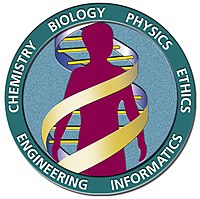
Photo from wikipedia
Purpose of review Genome sequencing is now available as a clinical diagnostic test. There is a significant knowledge and translation gap for nongenetic specialists of the processes necessary to generate… Click to show full abstract
Purpose of review Genome sequencing is now available as a clinical diagnostic test. There is a significant knowledge and translation gap for nongenetic specialists of the processes necessary to generate and interpret clinical genome sequencing. The purpose of this review is to provide a primer on contemporary clinical genome sequencing for nongenetic specialists describing the human genome project, current techniques and applications in genome sequencing, limitations of current technology, and techniques on the horizon. Recent findings As currently implemented, genome sequencing compares short pieces of an individual's genome with a reference sequence developed by the human genome project. Genome sequencing may be used for obtaining timely diagnostic information, cancer pharmacogenomics, or in clinical cases when previous genetic testing has not revealed a clear diagnosis. At present, the implementation of clinical genome sequencing is limited by the availability of clinicians qualified for interpretation, and current techniques in used clinical testing do not detect all types of genetic variation present in a single genome. Summary Clinicians considering a genetic diagnosis have wide array of testing choices which now includes genome sequencing. Although not a comprehensive test in its current form, genome sequencing offers more information than gene-panel or exome sequencing and has the potential to replace targeted single-gene or gene-panel testing in many clinical scenarios.
Journal Title: Current Opinion in Pediatrics
Year Published: 2017
Link to full text (if available)
Share on Social Media: Sign Up to like & get
recommendations!